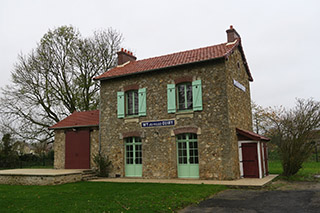Prochain point : lat="" lon=""
THE OLD TRAINSTATION
A train network linking the cities to the suburbs
A local line...
The local train network of the
Compagnie des chemins de fer de grande banlieue, (the greater suburban rail company), running between Meulan, Sagy and Magny-en-Vexin, with a junction linking Sagy to Pontoise, opened in 1913. It had around 35 km of track, which took a little over an hour and a half to cover. The network was opened progressively. In farming areas, the train, known to locals as the “tacot” (old boneshaker), was very useful for transporting cereals, beetroots, fresh fruit and vegetables and compost from household waste. Wy-dit-Joli-Village station welcomed travellers in a building of typical Vexin architecture. The station was built on two levels. The top floor is lit by two round windows called
oculi. It is simply decorated, with brick used to highlight the levels and frame the openings. The burrstone used no doubt comes from the Hazeville wood.
...quickly in decline
Right from its opening, there were multiple problems on the train line: complaints about the schedule, difficulties with the change at Sagy and problems with equipment. The First World War did nothing to improve the situation. As early as 1916, the network was abandoned and the tracks dismantled for use on the front. After the war, the tracks were rebuilt. During the Second World War, the “tacot” was the sole mode of long distance travel: the Germans used it to transport munitions. Little by little, roads replaced rail and the network was closed for good in 1949.

 >
>

